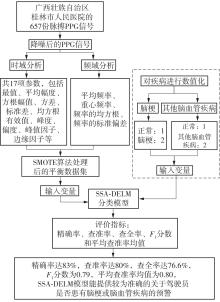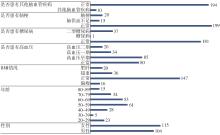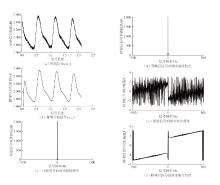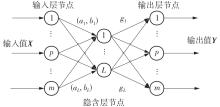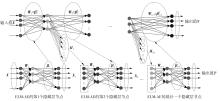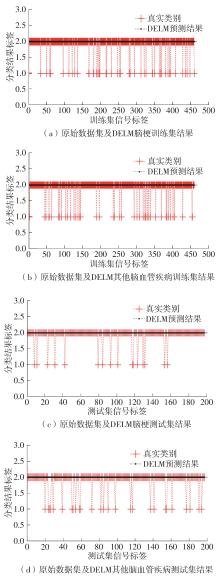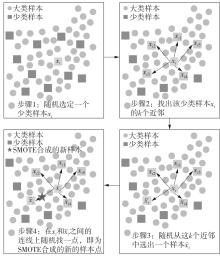Journal of South China University of Technology(Natural Science Edition) ›› 2023, Vol. 51 ›› Issue (7): 139-150.doi: 10.12141/j.issn.1000-565X.220571
Special Issue: 2023年交通运输工程
• Traffic & Transportation Engineering • Previous Articles
Identification Model of Driver’s Cerebrovascular Diseases Based on PPG Pulse Signal Features
ZHANG Jiaxun1 ZHENG Qiuna2 YU Zhenyu3 HUANG Ling3,4
- 1.College of Design and Engineering,National University of Singapore,117575,Singapore
2.Guangdong Road Transportation Affairs Center,Guangzhou 510101,Guangdong,China
3.School of Civil Engineering and Transportation,South China University of Technology,Guangzhou 510640,Guangdong,China
4.Modern Urban Transportation Technology Jiangsu University Collaborative Innovation Center,Southeast University,Nanjing 210096,Jiangsu,China
-
Received:2022-09-02Online:2023-07-25Published:2023-01-20 -
Contact:黄玲(1979-),女,博士,副教授,主要从事微观交通仿真建模及分析、交通图像分析、交通大数据处理、绿色交通系统等的研究。 E-mail:hling@scut.edu.cn -
About author:张嘉讯(2000-),女,博士生,主要从事智能交通检测预警技术研究。E-mail:e0954475@u.nus.edu -
Supported by:the Natural Science Foundation of Guangdong Province(2023A1515010742);the Key Project of Guangdong Regional Joint Fund(2020B1515120095)
CLC Number:
Cite this article
ZHANG Jiaxun, ZHENG Qiuna, YU Zhenyu, et al. Identification Model of Driver’s Cerebrovascular Diseases Based on PPG Pulse Signal Features[J]. Journal of South China University of Technology(Natural Science Edition), 2023, 51(7): 139-150.
share this article
Table 4
Classification results of other cerebrovascular diseases based on DELM and SSA-DELM models"
| 指标 | DELM分类结果 | SSA-DELM分类结果 |
|---|---|---|
| 训练集精确率/% | 61.37 | 81.45 |
| 测试集精确率/% | 60.53 | 83.01 |
| 标签1查准率/% | 64.15 | 85.84 |
| 标签2查准率/% | 65.91 | 80.78 |
| 标签1查全率/% | 60.00 | 81.99 |
| 标签2查全率/% | 69.76 | 76.63 |
| 标签1的F1分数 | 0.620 1 | 0.780 6 |
| 标签2的F1分数 | 0.677 8 | 0.792 2 |
| 平均查准率均值 | 0.659 4 | 0.801 1 |
| 1 | 国家统计局 .中国统计年鉴—2021[M].北京:中国统计出版社,2021. |
| 2 | ROLISON J J, REGEV S, MOUTARI S,et al .What are the factors that contribute to road accidents?An assessment of law enforcement views,ordinary drivers’ opinions,and road accident records[J].Accident Analysis & Prevention,2018,115:11-24. |
| 3 | FORT E, POURCEL L, DAVAZIES P,et al .Road accidents,an occupational risk[J].Safety Science,2010,48(10):1412-1420. |
| 4 | 马丽媛,王增武,樊静,等 .《中国心血管健康与疾病报告2021》概要[J].中国介入心脏病学杂志,2022,30(7):481-496. |
| MA Li-yuan, WANG Zeng-wu, FAN Jing,et al .Summary of China cardiovascular health and disease report 2021[J].Chinese Journal of Interventional Cardiology,2022,30(7):481-496. | |
| 5 | CHERIF F H, CHERIF L H, BENABDELLAH M,et al .Monitoring driver health status in real time[J].The Review of Scientific Instruments,2020,91(3):035110. |
| 6 | KOO C H, ZHU H, TSANG Y T,et .al.A portable system for multiple parameters monitoring:towards assessment of health conditions and stress level in the automotive field[C]∥ Proceedings of the AEIT International Conference of Electrical and Electronic Technologies for Automotive.Turin:[s.n.],2019. |
| 7 | LEE J-C, LIU H .Development of a real-time driver health detection system using a smart steering wheel[J].International Journal of Prognostics and Health Management,2018,9:1-5. |
| 8 | 于露,任晓阳,魏恒建,等 .基于PPG信号的驾驶员生理参数监测[J].大连交通大学学报,2023,44(2):22-27. |
| YU Lu, REN Xiaoyang, WEI Hengjian,et al .Driver physiological parameter monitoring based on PPG signal[J].Journal of Dalian Jiaotong University,2023,44(2):22-27. | |
| 9 | HAYASHI H, KAMEZAKI M, SUGANO S .Toward health-related accident prevention:symptom detection and intervention based on driver monitoring and verbal interaction[J].IEEE Open Journal of Intelligent Transportation Systems,2021,2:240-253. |
| 10 | LIANG Y, LIU G, CHEN Z,et al .Figshare[EB/OL].[2022-05-04]. . |
| 11 | MOODY G B, MARK R G .A database to support development and evaluation of intelligent intensive care monitoring[C]∥Proceedings of the Conference on Computers in Cardiology 1996.Indianapolis:IEEE,1996:657-660. |
| 12 | KACHUEE M, KIANI M M, MOHAMMADZADE H,et al .Cuff-less high-accuracy calibration-free blood pressure estimation using pulse transit time[C]∥ Proceedings of IEEE International Symposium on Circuits and Systems (ISCAS’15).[S. l.]:IEEE,2015. |
| 13 | SOREL J E, HEISS G, TYROLER H A,et al .Black-white differences in blood pressure:the authors reply[J].Epidemiology,1992,3(3):274-275. |
| 14 | 吴金奖,陈建新,田峰 .可穿戴心电信号监测中运动伪影消除技术研究[J].信号处理,2014,30(11):1388-1393. |
| WU Jin-jiang, CHEN Jian-xin, TIAN Feng .Research on motion artifacts eliminating for wearable electrocardiogram signal monitoring[J].Journal of Signal Processing,2014,30(11):1388-1393. | |
| 15 | 徐海津 .抗运动伪影下基于PPG的心率估计方法研究与应用[D].成都:电子科技大学,2018. |
| 16 | 於鹏,严良文,余越,等 .五点三次平滑算法在PPG信号降噪中的应用[J].计量与测试技术,2020,47(6):47-50,53. |
| YU Peng, YAN Liangwen, YU Yue,et al .The application of five-point cubic smoothing algorithm in noise reduction of PPG signal[J].Metrology & Measurement Technique,2020,47(6):47-50,53. | |
| 17 | 李苗,侯柏成,党豪 .基于深度卷积神经网络的ECG信号分类研究[J].电脑编程技巧与维护,2023(1):131-133. |
| LI Miao, HOU Bo-cheng, DANG Hao .Research on ECG signal classification based on deep convolutional neural network[J].Computer Programming Skills and Maintenance,2023(1):131-133. | |
| 18 | ELGENDI M .Optimal signal quality index for photoplethysmogram signals[J].Bioengineering,2016,3:3040021/1-15. |
| 19 | LIANG Y, ELGENDI M, CHEN Z,et al .An optimal filter for short photoplethysmogram signals[J].Scientific Data,2018,5:180076. |
| 20 | LIANG Y,HEN Z, LIU G,et al .A new,short-recorded photoplethysmogram dataset for blood pressure monitoring in China[J].Scientific Data,2018,5:180020. |
| 21 | 宋海亮 .基于CAN的汽车制动测试系统的研究与实现[D].上海:上海交通大学,2011. |
| 22 | 于萍 .用小波技术实现非平稳信号的处理[D].青岛:中国石油大学(华东),2012. |
| 23 | 陈慧慧 .自动机运动规律图像数据处理方法研究[D].太原:中北大学,2010. |
| 24 | 杨依,方亮,岳宏,等 .脉搏波传导速度、踝臂指数及体脂肪率在心血管风险评价中的应用[J].航空航天医学杂志,2015,26(4):393-395. |
| YANG Yi, FANG Liang, YUE Hong,et al .Pulse wave conduction velocity,ankle arm index and body fat rate in the application of cardiovascular risk assessment[J].Journal of Aerospace Medicine,2015,26(4):393-395. | |
| 25 | 宋晓瑞,乔爱科 .基于脉搏波检测技术的心血管健康评测[J].医用生物力学,2015,30(5):468-473. |
| SONG Xiao-rui, QIAO Ai-ke .Evaluation of cardiovascular health based on pulse wave detection technology[J].Journal of Medical Biomechanics,2015,30(5):468-473. | |
| 26 | 齐咏生,樊佶,李永亭,等 .基于增强型形态学滤波的风电机组轴承故障诊断方法[J].振动与冲击,2021,40(4):212-220. |
| QI Yongsheng, FAN Ji, LI Yongting,et al .A fault diagnosis method of wind turbine bearings based on an enhanced morphological filter[J].Journal of Vibration and Shock,2021,40(4):212-220.. | |
| 27 | 罗通元 .风险预警技术在往复泵系统中的应用[D].北京:中国石油大学(北京),2016. |
| 28 | 李祝强 .基于局部线性嵌入和支持向量机的滚动轴承性能退化评估研究[D].哈尔滨:哈尔滨理工大学,2014. |
| 29 | 王海龙,李云赫,赵岩 . k值优化VMD-小波包分析联合降噪方法在隧道爆破信号中的应用[J].爆破器材,2021,50(5):50-57. |
| WANG Hailong, LI Yunhe, ZHAO Yan . k-value optimization of VMD-wavelet packet analysis joint noise reduction method in tunnel blasting signal[J].Blasting Equipment,2021,50(5):50-57. | |
| 30 | 吴忠强,毛志华,王正,等 .基于极限学习机的浅海水深遥感反演研究[J].海洋测绘,2019,39(3):11-15. |
| WU Zhongqiang, MAO Zhihua, WANG Zheng,et al .Research on remote inversion of shallow sea bathymetry based on extreme learning machine[J].Hydrographic Surveying and Charting,2019,39(3):11-15. | |
| 31 | 江晗菁 .基于SSDA-HELM-SOFTMAX的农业投入品在线分类预测方法研究与实现[D].广州:仲恺农业工程学院,2020. |
| 32 | 颜学龙,马润平 .基于深度极限学习机的模拟电路故障诊断[J].计算机工程与科学,2019,41(11):1911-1918. |
| YAN Xue-long, MA Run-ping .Fault diagnosis of analog circuits based on deep limit learning machine[J].Computer Engineering and Science,2019,41(11):1911-1918. | |
| 33 | 马润平 .基于深度极限学习机的模拟电路故障诊断研究[D].桂林:桂林电子科技大学,2020. |
| 34 | LU X, ZOU H, ZHOU H,et al .Robust extreme learning machine with its application to indoor positioning[J].IEEE Transactions on Cybernetics,2015,46(1):194-205. |
| 35 | SHI L C, LU B L .EEG-based vigilance estimation using extreme learning machines[J].Neurocomputing,2013,102:135-143. |
| 36 | 张文帅,王占刚 .基于改进麻雀算法优化深度极限学习机的缺失数据预测[J].电子测量技术,2022,45(15):63-67. |
| ZHANG Wenshuai, WANG Zhangang .Missing data prediction based on improved sparrow algorithm optimized deep extreme learning machine[J].Electronic Measurement Technology,2022,45(15):63-67. | |
| 37 | CHAWLA N V, BOWYER K W, HALL L O,et al .SMOTE:synthetic minority over-sampling technique[J].Journal of Artificial Intelligence Research,2002,16(1):321-357. |
| [1] | ZHAO Xiaohua, ZHU Hongzhen, BIAN Yang, et al. Research on Self-Regulation Behavior of Elderly Drivers Based on Extended TPB Model [J]. Journal of South China University of Technology(Natural Science Edition), 2022, 50(3): 28-37. |
| [2] | GUO Peng, HU Xingjun, GAO Hao, et al. Influence of Parked Car Ventilation Parameters on Driver Compartment Cooling after Hot Soak [J]. Journal of South China University of Technology (Natural Science Edition), 2020, 48(2): 76-83. |
| [3] | SUN Bohua, DENG Weiwen, HE Rui, et al. Longitudinal Stimuli-Based Classification and Recognition Method for Driving Styles [J]. Journal of South China University of Technology (Natural Science Edition), 2019, 47(11): 33-43. |
| [4] | LI Shi-wu YIN Yan-na WANG Lin-hong XU Yi . Driving Fatigue Quantization Based on Entropy Weight Method [J]. Journal of South China University of Technology (Natural Science Edition), 2017, 45(8): 50-56. |
| [5] | ZHANG Wen-ming HAN Hong-bing YANG Jue YI Xiao. A Neural Network-Based Autonomous Articulated Vehicle System Considering Driver Behavior [J]. Journal of South China University of Technology (Natural Science Edition), 2016, 44(12): 74-80. |
| [6] | Wang Zhen- min Zhang Qin Du Gui- ping . Design and Experimental Analysis of High- Frequency Driver for High- Power Module [J]. Journal of South China University of Technology (Natural Science Edition), 2013, 41(7): 50-55. |
| [7] | Liu Ying- jie Zhao You- qun. Solving of Inverse Dynamics for Lane- Change Steering Maneuver Based on Model Predictive Control [J]. Journal of South China University of Technology (Natural Science Edition), 2013, 41(11): 120-124. |
| [8] | Zhuang Jia-jun Liu Qiong. Nighttime Pedestrian Detection Method for Driver Assistance Systems [J]. Journal of South China University of Technology(Natural Science Edition), 2012, 40(8): 56-62. |
| [9] | Zheng Xue-ren Chen Guo-hui Deng Wan-ling Yao Ruo-he Chen Ling-jing Fan Jian-min. Development and IP Verification of Control Software of IP Design-Simulation Platform [J]. Journal of South China University of Technology (Natural Science Edition), 2005, 33(9): 15-19. |
| [10] | Liu Su-yi Wang Guo-rong Guo Lie-en. Design of a High-speed Data Sampling System Based on ISA Bus [J]. Journal of South China University of Technology(Natural Science Edition), 2004, 32(8): 34-37. |
| [11] | Wu Jie, Lei Chun- lin, Chen Yuan- rui, et al. Motor Servo Driver Based on Intelligent Power Module [J]. Journal of South China University of Technology(Natural Science Edition), 2004, 32(12): 61-64,73. |
| Viewed | ||||||
|
Full text |
|
|||||
|
Abstract |
|
|||||
